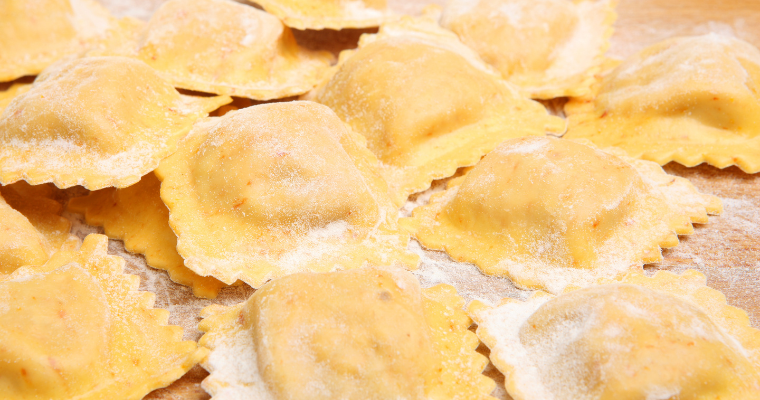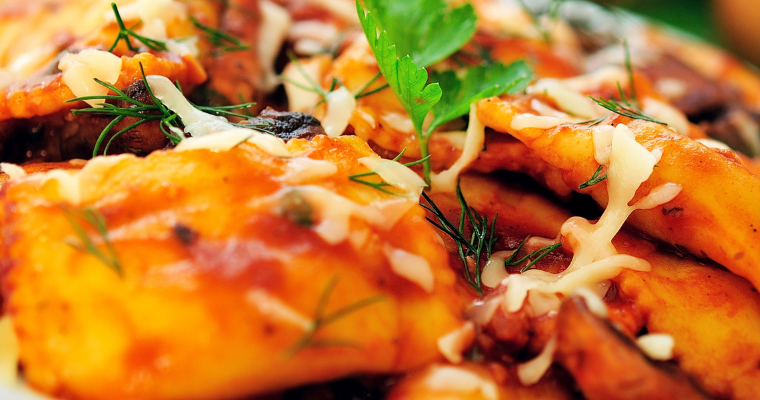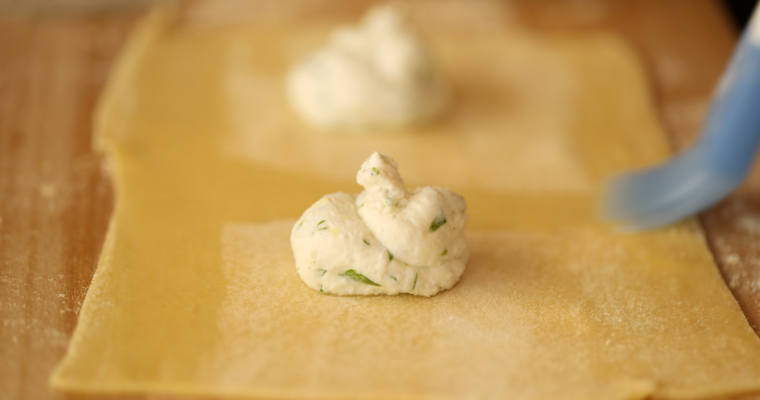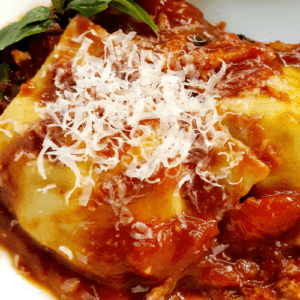Italian Sausage Ravioli

Ravioli is a type of Italian pasta consisting of a filling sealed between two layers of thin pasta dough. They’re pillowy soft, super tender and can be stuffed with a variety of fillings and topped with a number of different sauces.
The filling can be made with a variety of ingredients, such as cheese, meat, vegetables, or a combination of these. Ravioli is typically boiled in salted water and served with a sauce, such as tomato sauce, cream sauce, or butter and sage. It is a popular dish in Italian cuisine and is enjoyed in many parts of the world.
This Italian sausage filling really can’t get any easier. Cooked skinless sausages are mixed with spinach, ricotta and an egg to bind. Its lovely served with a simple tomato sauce.
You can double the pasta quantity for this recipe, you will have enough filling so won’t need to double that.
Tips For Making Ravioli
- Start with a good pasta dough: Thermomix makes a great pasta dough but remember it is important to let the dough rest for 30 minutes before rolling.
- Roll the pasta thin: Roll your pasta dough as thin as possible, without tearing it. The thinner the pasta, the better the texture of your finished ravioli. Roll the pasta dough out into thin, even sheets, so that it’s easy to shape and fill. I aim for around 1 mm.
- Use fine semolina flour to dust your pasta, pasta roller and workbench.
- Use a good filling: The filling is another important component of ravioli. You can use a variety of fillings, from cheese and spinach to meat and vegetables. Just make sure your filling is not too wet or it may leak out during cooking, and the dough may become mushy.
- Use a ravioli cutter: A ravioli cutter makes it easy to cut out uniform squares of pasta and also seals the edges around the filling. If you don’t have a ravioli cutter, you can use a knife or pastry cutter to cut out the squares and a fork to seal the edges.
- Seal the ravioli well: Use a little bit of water to moisten the edges of the pasta dough, then press the edges firmly together to seal the ravioli.
- Cook in boiling water: Bring a large pot of salted water to a boil and gently add the ravioli. Remember 1 tsp salt to 1 ltr water. Cook for about 3 minutes or until the pasta is tender and the filling is cooked through. The ravioli will float to the surface. Be careful not to overcook them, as they can become mushy.

Shaping Pasta with a Pasta Roller
- Once rested, cut the pasta dough into 2 equal pieces. Flatten one piece into a disc (re-wrap or cover the remaining piece so it does not dry out).
- Roll on the widest/lowest setting. This is #1 on the kitchen Aid attachment, if using a manual pasta machine, refer to the instructions for rolling the dough for ravioli. On most, the the settings are reversed, but the process is the same
- Fold and send through a few more times, folding each time. You will notice the pasta smooths out.
- Continue to roll the dough through settings #2-5. Roll through twice on each setting, no need to fold.
- Your pasta pasta sheet should be slightly translucent and you can see your hand underneath – about 1 mm thick.
- When finished, place onto a tray sprinkled with semolina flour. Repeat with the second piece of pasta dough
Shaping Ravioli
The fold-over method is one way to shape ravioli, and it involves folding a sheet of pasta dough over a filling to create individual pockets. Here are the steps to follow, it is also covered in the video below.
- Roll out your pasta dough to the desired thickness as described above
- Place a heaped spoonful (or use a piping bag) of your chosen filling at regular intervals along one half of the pasta sheet, leaving enough space between each spoonful to create individual ravioli, and about 1cm from the edge.
- Brush some water on the edges and in between each filling dome.
- Fold the other half of the pasta sheet over the filling, pressing down gently around each mound of filling to remove any air pockets.
- Use a ravioli cutter, a knife or a pastry cutter to cut the pasta sheet into individual ravioli, being careful to seal the edges well to prevent the filling from leaking out during cooking.
- Repeat the process with the remaining pasta and filling until you have the desired number of ravioli.

How To Cook Homemade Ravioli
I recommend cooking a test batch first until you get the hang of things. When you are starting out your pasta thickness can vary.
Add two ravioli into a pot of boiling salted water. Cook for 3-6 minutes or more, depending on the thickness of the ravioli. Keeping an eye on time, pull one out to test when you think its cooked. Taste for doneness. If it needs a bit more time you have an extra one to test! When happy continue to cook the main batch with confidence!
When cooked, gently transfer the ravioli to a serving dish with a fine mesh strainer. They are delicate! Top with a little sauce, garnish and serve
Popular fillings
You really can use whatever you like to fill your ravioli and don’t forget about using up leftovers! I always try and make a mouse like filling, adding an egg often helps to bind the mixture together, but make sure its not too wet and soggy! If using ricotta as a main ingredient for your filling, it is a good idea to drain it overnight.
Some of the most common fillings for ravioli include:
- Cheese: Cheese is a classic filling for ravioli, and can include ricotta, mozzarella, Parmesan, or a combination of cheeses.
- Meat: Ravioli can also be filled with various types of meat such as beef, pork, chicken, or sausage.
- Spinach: Spinach is a popular filling for vegetarian ravioli, often mixed with ricotta cheese.
- Mushrooms: Mushroom ravioli is another vegetarian option, often filled with a mixture of mushrooms, herbs, and cheese.
- Seafood: Ravioli can also be filled with seafood such as prawns, crab, or lobster.
- Pumpkin: Another popular option, often mixed with sage and butter.
- Eggplant: Eggplant-filled ravioli is a delicious vegetarian option, often mixed with tomato sauce and basil.
- Artichoke: Artichoke-filled ravioli is another vegetarian option, often mixed with spinach and cheese.
- Truffle: Truffle-filled ravioli is a decadent and luxurious option, often mixed with butter or cream sauce.
Experiment, create your own favourite!
A Quick Ricotta filling
Mix the following in a bowl.
- 100 mascarpone cheese
- 100g drained ricotta
- 1 tbsp chopped basil leaves
- 40g freshly grated Parmesan cheese
- 1 egg
- Salt & pepper, to taste

Storing Homemade Ravioli
Homemade ravioli can be stored in the refrigerator or freezer, depending on how soon you plan to use them. Here are some storage tips:
- Refrigerator storage: If you plan to use your homemade ravioli later in the day, you can store them in the refrigerator. Place the ravioli on a baking sheet lined with baking paper, making sure they are not touching each other. Cover the baking sheet with plastic wrap and refrigerate until ready to use. It is best if you use it on the day you make it. Often the fillings make the ravioli become soft and soggy and the pasta can oxidise if left overnight.
- Freezer storage: If you have made a large batch of ravioli and want to store them for later, you can freeze them. They freeze well for up to one month, after that the texture changes. Place the ravioli on a baking sheet lined with baking paper, making sure they are not touching each other. Place the baking sheet in the freezer for several hours or until the ravioli are frozen solid. Then, transfer the frozen ravioli to a freezer-safe container, plastic bag, label and date it, and return it to the freezer. They freeze well for up to one month. If you vacuum seal, don’t do a tight vacuum or it will crack the ravioli.
- Cooked ravioli: You can also store cooked ravioli in the refrigerator for a day or two or in the freezer for up to a month. Simply let the cooked ravioli cool completely, place them in a container or plastic bag, and refrigerate or freeze until ready to use.
Watch me make pasta, sausage filling and shape the ravioli

Italian Sausage Ravioli
Equipment
- TM5 or TM6
- Pasta machine optional but easier!
Ingredients
PASTA DOUGH
- 200 grams 00 flour
- 2 large eggs
- 1 tbsp olive oil
- pinch salt
Ravioli Filling
- 2 Italian sausages casings removed and chopped into 2 cm pieces
- 1 large egg
- 100 grams ricotta
- 60 grams baby spinach
- 40 grams parmesan cheese grated
- salt and pepper to season
Sauce
- 2 tbsp olive oil
- 1 small onion or large shallot peeled and cut in 1/4
- 2 cloves garlic peeled
- 300 grams tomato passatta
- 1 tsp Italian herbs
- 1/2 tsp sugar
- 1 tsp red wine vinegar
- 1 tsp chicken or vegetable stock paste optional
- salt and pepper to taste
Instructions
Pasta Dough
- Add Flour, eggs, olive oil and salt to Thermomix bowl and select dough function/2 minute.
- Tip dough onto a thermomat or lightly floured kitchen bench. It will look like small crumbs. Bring together in a ball. Cover in plastic wrap and rest for 30 mins. While resting, make filling.
Ravioli Filling
- Add sausage to Thermomix bowl and saute 8 mins/100℃/ speed 0.5/measuring cup off, simmering basket sitting on lid. Add chopped spinach and cook 2 mins/100℃/speed 0.5/measuring cup off, simmering basket sitting on lid. Tip into a bowl and set aside to cool.
- Once cool, add egg, ricotta, parmesan and seasoning. Mix well by hand. Taste, adjust seasoning if needed. Set aside.
- Use filling to fill and create ravioli as detailed in the notes.
Sauce
- Add onion and garlic to Thermomix bowl and chop 3 secs/speed 5. Scrap down bowl,
- Add olive oil and saute 4 mins/100℃/ speed 1/measuring cup off and simmering basket sitting on lid.
- Add remaining sauce ingredients and cook 10mins/100°/speed 1/measuring cup off/simmering basket sitting on lid.
- Taste and adjust seasoning. Cook for a further 5 mins/100°/speed 1/measuring cup off/simmering basket sitting on lid.
- Place 3 large ravioli into a bowl and cover with a little sauce. Garnish with shaved parmesan and basil.
